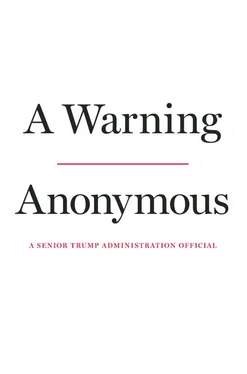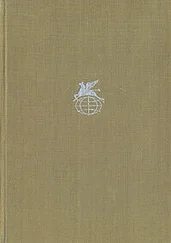These mini crises didn’t happen once or twice at the administration’s outset. They became the norm, a semi-regular occurrence with aftershocks that could be felt for days. Some aides grew so worn down by the roller coaster of presidential whims that they started encouraging him to hold more campaign rallies, putting aside the fact that it wasn’t campaign season. The events had the dual benefit of giving Trump something “fun” to do and also getting him out of town, where he would hypothetically do less damage. More public events were put on his schedule, allowing frayed nerves back in Washington the chance to recover.
Yet even when the president was convinced not to do something spontaneous and given a few days’ distance from the idea, he would still bring it back up when he got back to town. That’s the storyline of many of the anecdotes referenced in this book. It might be a desire to fire someone who’d only recently been confirmed by the Senate, like his Federal Reserve chairman, or an itch to issue an executive order to end a deal he hates, like the North American Free Trade Agreement (NAFTA). His cyclical urges can’t be suppressed for long.
Steady Staters felt this was becoming a seesaw presidency.
Whether you were “all in” on the president’s agenda or not, one reality couldn’t be denied—lurching from one spontaneous decision to another was more than a distraction. The day-to-day management of the executive branch was falling apart before our eyes. Trump was all over the place. He was like a twelve-year-old in an air traffic control tower, pushing the buttons of government indiscriminately, indifferent to the planes skidding across the runway and the flights frantically diverting away from the airport. This was not how it was supposed to be.
Every White House in recent history instituted a deliberate process by which decisions were made and executed. Policies were carefully considered, final decisions were carried out with a step-by-step plan, partners at other levels of government were rarely caught off guard by White House positions, the paperwork and information the president received was properly vetted and fact-checked, and someone was in charge of overseeing hiring and firing. Family members were kept at a safe distance, and in cases where they participated in governing, like Bobby Kennedy, most had clearly defined roles. Great deference was given to ethics officials and the White House counsel’s office, who acted as watchdogs against inappropriate activities by members of the presidential staff. This was all undertaken to ensure the presidency was operating within or sometimes to the limit of its constitutional authorities and in compliance with federal laws. Not in the Trump administration. This approach was abandoned through inattention, intention, incompetence, or all three.
Fundamentally, the president never learned to manage the government’s day-to-day functions, or showed any real interest in doing so. This remains a problem. He doesn’t know how the executive branch works. As a consequence, he doesn’t know how to lead it. The policymaking process has suffered considerably. On any given issue—say, how to fix health care—there is daily confusion between departments and agencies about what the plan is and who is in charge. He tells the secretary of defense to do things that are the responsibility of the secretary of state. He tells the attorney general to do things that are the job of the director of National Intelligence. Sometimes he tells his son-in-law, Jared Kushner, to do all of their jobs at once, including reimagining care for America’s veterans, negotiating Middle East peace, spearheading criminal justice reform, and undertaking delicate conversations with foreign allies.
Jared is a likable person, a youthful and energetic advisor and an empathetic listener. However, when the secretary of defense is cut out of Jared’s meetings regarding a crucial part of the world, or the national security advisor isn’t back-briefed on an important conversation Kushner has with a foreign ambassador, it can cause problems, sometimes big problems. It isn’t clear the president is satisfied that so many issues run through his son-in-law’s office, but the arrangement persists because Jared is careful to always demonstrate loyalty to his wife’s father, even at the expense of his standing among other top officials. Thus, the unclear and unhealthy lanes of authority persist.
The White House, quite simply, is broken. Policies are rarely coordinated or thoroughly considered. Major issues are neglected until a crisis develops. Because there is no consistent process, it is easy for the administration to run afoul of federal laws, ethics guidelines, and other norms of behavior. We will walk through a fraction of the mind-numbing examples in this book, but it will take many years to fully capture the scope of the unruliness.
There is no shortage of people, inside and outside the administration, who want to convince you and themselves that this is an act of three-dimensional chess. Trump is doing all of this for a reason. Just wait and see. It’s part of his genius. During the administration’s infancy, a handful of aides went as far as to argue that management-through-chaos was an asset. Among them was Stephen Miller, a senior advisor to the president and early campaign hand Trump inherited from Jeff Sessions. He is a hard-liner who developed a name for himself in certain Washington circles with his preachy warnings about illegal aliens and for filibustering on these themes in conversation. A cunning aide who relishes having the president wrapped around his finger on any number of issues, Miller back-channels his side of the story to the press, and works daily to outwit other aides who sit just down the hall from him. Like Jared, he is careful not to show daylight between himself and the president, for fear of losing his stature as a Trump whisperer.
Stephen has argued that Donald Trump’s impulses needed to be encouraged, not tempered. From the beginning, he agitated for the White House to “flood the zone” by issuing as many dramatic policy changes as possible, regardless of whether they would withstand legal scrutiny. It would shock the system and put “the opposition” (Democrats) on their heels, he contended. It would also create powerful distractions the White House could exploit, drawing fire away from the real policies hard-liners cared about. To Stephen, chaos is a deliberate governing strategy.
He is not alone in the misguided view. A now former top aide was fond of comparing the president to General George S. Patton. Contemporaries could never predict what Patton was going to say or do. “That’s how I like it,” General Patton is said to have remarked. He wanted to keep everyone, especially the enemy, on their toes. “That is the political genius of Trump,” the aide reminded us during a heated debate over a particularly troublesome presidential decision. “He is just like Patton.” The argument might have some merit, if the president displayed any sense that he knew what he was doing.
The Steady State grew more worried about the condition of the executive branch. The Patton approach doesn’t work in a democracy. It’s okay to leave foreign enemies on a battlefield confused about what you are planning, but not the American people or the Congress or your friends and allies. Officials decided they didn’t want the president’s willingness to play fast and loose with the powers of government to trickle down to lower levels of the bureaucracy, where they could infect the culture. Department and agency heads started insulating their operations from Trump’s whims and created separate discussion forums run outside of the White House. They confessed wariness about sending staff to the West Wing for meetings, not wanting more junior officials to see how bad it was or partake in the gross mismanagement.
Читать дальше





![Автор неизвестен Детская литература - Верхом на урагане [Из американского фольклора]](/books/25390/avtor-neizvesten-detskaya-literatura-verhom-na-urag-thumb.webp)


